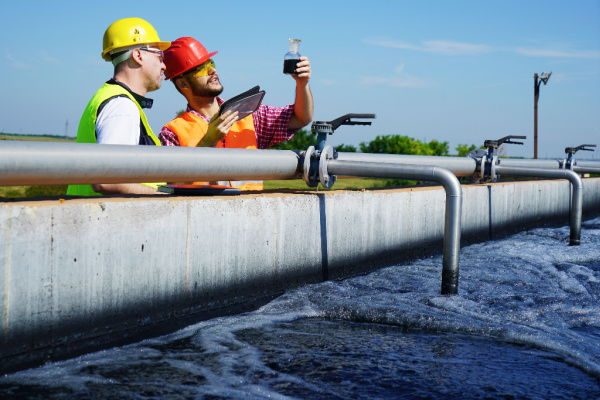As CNN reports, early in the coronavirus pandemic, health officials closely monitored sewage samples for signs of the virus to track where it could be circulating. Now, that technique is being used to detect other infectious diseases: polio and monkeypox.
Some disease detectives in the United States are narrowing their wastewater surveillance efforts to zero in on specific buildings and to identify hot spots for a growing list of diseases.
“Some wastewater surveillance is done at the community level, and some is done at the building level, which is a little bit better nuanced in terms of trying to target messaging,” said Lori Tremmel Freeman, chief executive officer of the National Association of County and City Health Officials. “For example, in some of our jurisdictions, they’ll monitor a large hotel or a prison setting,” she said. “If it pops up there, you can target messaging directly to that building.”
A building-level approach to wastewater surveillance is underway at all 11 hospitals within the NYC Health + Hospitals integrated health care system in New York City. The system launched a surveillance program in February to test sewage for coronavirus and flu viruses in wastewater from its hospitals, and the program expanded in August to include testing for polio and monkeypox, according to a company announcement.
“With the increase in rapid tests and the decline of federal funding for the Covid response this spring, wastewater testing was an affordable, easy way for us to track the presence of Covid in the community without needing patients to take a test,” Dr. Mitchell Katz, president and CEO of NYC Health + Hospitals, said in the announcement. “Now, with the arrival of monkeypox and polio in New York City, we have a system in place to test for those viruses and use that data to inform our response.”
Using the wastewater testing data, “we’ve been able to tell about 10 to 14 days prior to when we’re going to see an onset of having our patients show up sick,” Silvera said. “People are shedding the virus when they use the bathroom,” she said. “So if we’re testing our wastewater, then we can tell whether or not there’s an uptick in virus in the community at that given point. And then it ends up showing when people start presenting symptoms 10 to 14 days later.”
According to the US Centers for Disease Control and Prevention (CDC), wastewater surveillance involves testing sewage to determine whether feces and other types of human waste in untreated sewage contain genetic material from viruses or bacteria that can make people sick. That material, either RNA or DNA, can be detected in wastewater — but it does not indicate whether the pathogen is infectious in the water itself.
“We’re really focused on understanding what is the burden of disease and how much disease is in the community with these measurements,” said Marlene Wolfe, an assistant professor of environmental health at Emory University and co-principal investigator for WastewaterSCAN, a national wastewater surveillance initiative.
“Wastewater surveillance, the reason it works so well is because everyone in the community is contributing their sample to the sewer system daily,” she said. “For some places, that might be most of the population of the county is contributing to that one plant, and for some places, it might be that even in just one city, there are several plants that are covering different parts of the population.”
According to the National Library of Medicine, wastewater surveillance dates to the 1940s, when researchers used it to find carriers of the bacteria that cause typhoid fever or to detect polio. Since then, wastewater surveillance has been used to help with tracking infectious diseases on a global scale — but the technique was far from mainstream before Covid-19 emerged. This coronavirus is the first respiratory virus tracked with wastewater, Wolfe said.
In response to the pandemic, the CDC launched the National Wastewater Surveillance System in September 2020. Local public health departments use it to submit their wastewater testing data to CDC. The system analyzes that data and reports the results back to the health departments for use in their Covid-19 response.
According to CNN, the WastewaterSCAN initiative, based at Stanford University and completely separate from the CDC’s system, launched in November 2020 to scan sewage samples for SARS-CoV-2, the virus that causes Covid-19. Since then, the program has expanded to monitor more sewage plants and track more pathogens.
As of last week, the initiative — which involves a partnership between universities, nonprofits and the research company Verily — monitors 48 treatment plants across 16 states for the coronavirus and its BA.4 and BA.5 subvariants, as well as monkeypox, influenza A and respiratory syncytial virus.
When new threats emerge, it is “relatively easy” to use wastewater samples from the initiative to immediately test for whatever that threat might be, Wolfe said.
“That’s what we were just recently able to do for monkeypox, which was really exciting because we were able to roll it out very quickly, and we saw in a number of places, including Atlanta, that we had monkeypox DNA detectable in the wastewater from the time we started monitoring, which was pretty early in the outbreak,” she said. “That’s the advantage of having this kind of population-level network that allows us to speak to the overall trends in infectious disease outbreaks.”
—
Photo Credit: Avatar_023 / Shutterstock.com
